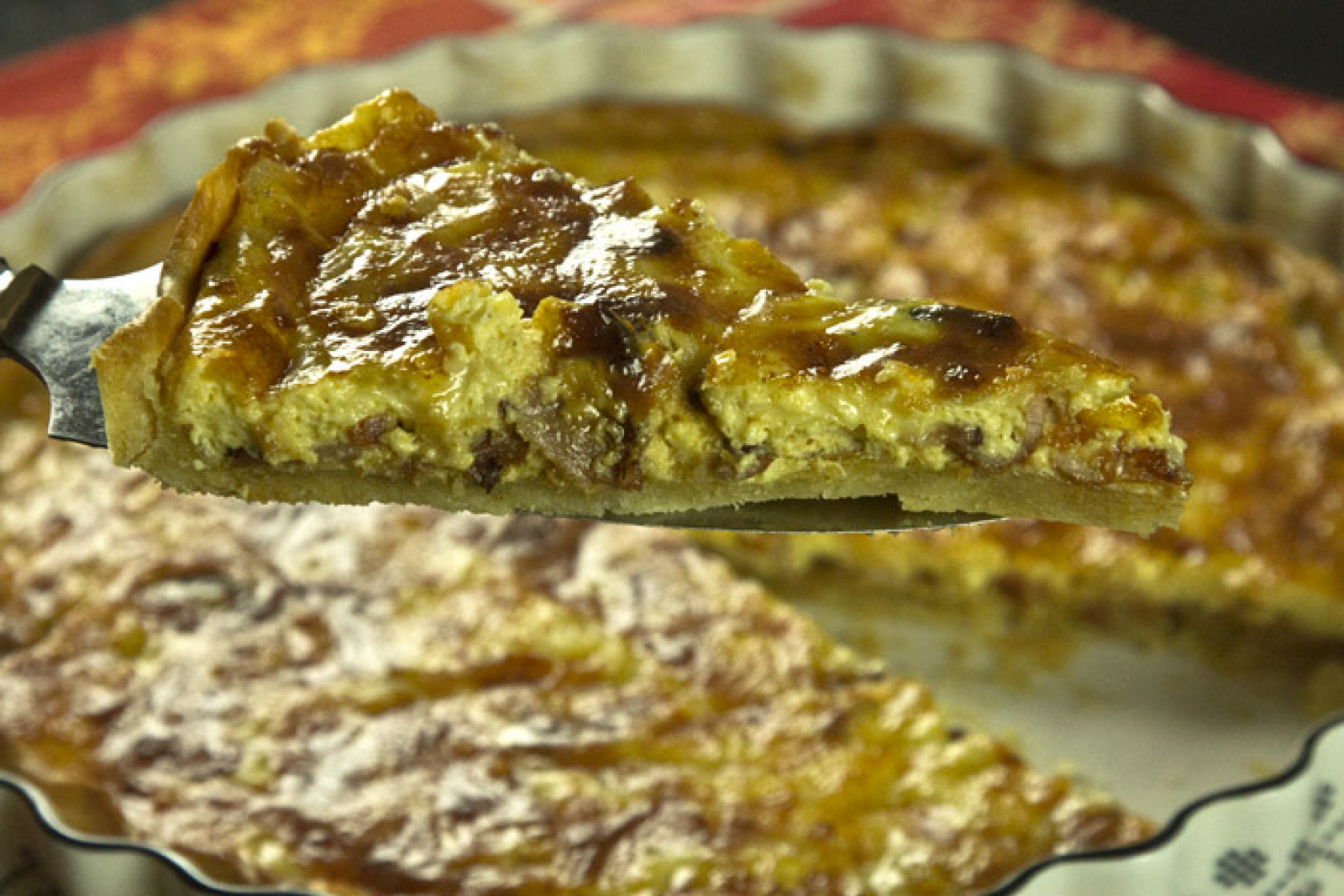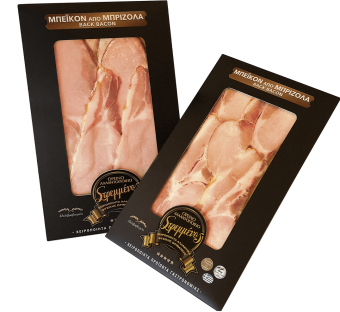

SUGGESTS YOU TRY
Quiche Lorraine is suitable either as a snack or as an appetizer but also as a first course in a meal followed by an exuberant meat or poultry with intense sauce.
A recipe with two preparations, the base (pâte brisée) and the filling, which do not present any technical difficulty. We suggest a double-bake technique on the patty breeze that ensures absolute crispness and simply adds a small 2 minute step to the process. Your total engagement will be about an hour, with an interval of half an hour needed for the pâte brisée to rest, during which time you will be caramelizing the bacon.
Many thanks to Cucina di Caruso!
Ingredients for one quiche in a 30 cm baking tray
For the pâte brisée
- 250 gr all purpose flour
- 120 gr butter straight from the fridge, cut into cubes
- ¼ tsp salt
- 120 ml ice water (really cold!)
For the filling
- 240 gr smoked bacon Stremmenos
- 20 gr butter
- 400 gr fresh cream
- 200 gr Swiss gruyere or emmental coarsely ground
- 2 eggs
- 4 egg yolks
- ¼ tsp nutmeg
- pepper
Note: If you use a 26 cm baking tray, roughly calculate 180-200 gr bacon, 300 gr fresh cream, 150 gr cheese and 2 eggs + 3 yolks. You should have a little dough left over.
Prepare the pâte brisée dough
The first step in creating the dough is to mix the flour with the salt and butter and this will ideally be done with a mixer, but it can also be done by hand. So if you choose to make the dough in the food processor / mixer:
- Mix the flour with the salt in the bucket
- At this point, cut the butter into relatively small cubes, as it is cold from the fridge, and toss them on top.
- Work it at low speed so that the butter gradually breaks into very small pieces and binds with the flour.
- The mixture should have a uniform texture, reminiscent of sand grains.
- Transfer the mixture to a pastry bowl.
Alternatively you can do this process with your hands in a bucket, although the temperature of the hands negatively affects the process as it helps to create gluten that we want to avoid. So if you do this, make sure the butter cubes are small and cold and do not overdo it when rubbing. Here the mixing of the two ingredients is done mainly with the fingers that rub the butter together with the flour and gradually succeed in creating a uniform texture. We just mention it to see what happens, but prefer the first method with the mixer.
In the second stage, ice water will be added and the dough will be molded:
- ΣIn the bowl of the flour and butter mixture, form a well in the center and slowly pour in half the amount of ice water while you start to stir with strong swift movements and knead as much as possible.
- Add as much water as needed to form a single ball while continuing the rudimentary kneading.
- Wrap it in cling film and refrigerate for 30 minutes.
Prepare the bacon
- In a pan over medium heat, melt the butter and add enough bacon so that the pan is not overcrowded.
- You will sauté them slowly, to melt their fat and caramelize as everything will take on a golden brown appearance and become crunchy.
- It will take about 3-4 minutes on each side, so a total of 7-8 minutes for each batch.
- You will leave them on kitchen paper to dry.
- Then, when they cool and are now crunchy, wipe them a little on top and cut them into small pieces, with scissors or a knife.
Spread the dough on the baking tray
- Preheat the oven to 180°C.
- Once the obligatory stay of the patty breeze in the fridge is over, you will take it out and spread it on the baking tray.
- You can do this with a rolling pin, but it is probably easier to spread it by hand, starting from the center of the pan and going to the sides.
- Make holes with a fork all over the surface of the dough to avoid puffing up to a point.
- Then cut a grease gun to the diameter of the pan and put on it either the special weights for baking, or beans, or washed coins, again to prevent the dough from puffing.
Bake the pâte brisée, without filling, in two stages
- Place the baking tray in the oven on a medium rack to pre-bake for 15' in the first stage.
- In the meantime, beat an egg because you will need it soon.
- At 15', remove the half-baked patty steak from the oven, empty it from the weights and with a brush pass its surface with a little of the beaten egg.
- This process will completely waterproof the dough, so it will stay crisp until the end, despite the fact that liquid filling will soon enter.
- Return the empty tart with the dough to the oven for another 10'. That is a total of 25' baking that we divided into two stages (15' +10') to do the waterproofing.
Prepare the cream
- While the quiche is cooking in the second stage of the process, empty the creams into a container. If the solids have separated with their liquids, you will hit them a little with the wire, so that they become viscous.
- Take the bowl with the 1 beaten egg, and add another one and the 4 yolks.
- Now you will throw all the eggs in the cream, and you will fill it with pepper and nutmeg.
- You do not add salt mainly because of the bacon which is salty anyway.
- Mix the ingredients well so that they are homogenized and ready to be added to the tart together with the cheese and bacon.
Finalising the Quiche Lorraine
- Once the tart has come out of the two baking stages, you can put in the filling.
- You will first spread the caramelized bacon all over the now glossy dough, and then you will throw the grated cheese.
- Finally, carefully pour the cream-egg mixture from the container so that it goes everywhere, among the other solid ingredients. Because the liquid can reach the very edge of the tart, we suggest that this process be done halfway on the counter, put the quiche in the oven and add the last piece of cream there, so that it does not risk spilling on the transport.
- You will put the tart, now complete, to bake for 30' in the oven at 180°C up and down.
- The last 5' you can put the oven on the upper resistance with air to give a deep golden color to the surface of the tart.
- When you take it out, you will let the temperature drop for at least 20' so that the ingredients will bind, cut and you can enjoy it!
Serving
You will bring the quiche to the table whole and you will cut the pieces there in front of the audience who will not be able to wait for the smell alone. The cutting process is not very easy in the pan, so a round pizza knife-wheel, or a similar knife may suit you.
